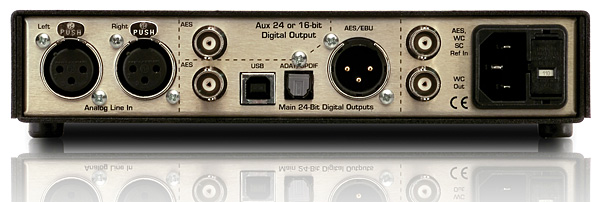| Columns Retired Columns & Blogs |
Benchmark ADC1 USB A/D converter

Erick Lichte's review of Benchmark's DAC2 HGC D/A converter in this issue gave me an ideal opportunity to spill some ink on the company's ADC1 USB A/D converter. The ADC1 is housed in the same small case as the DAC (one rack unit high, half the rack unit width), and is offered with a black front panel with rack ears, or a silver aluminum panel without ears, either for $1795.
The front panel offers, from left to right: a Mode toggle to switch between internal and external clocks; a second toggle to select the sample rate (44.1, 48, 88.2, 96, 176.4, 192kHz) for the Main and Auxiliary outputs and to select ADAT or AES/EBU data formats; a third toggle to select the meter range (1dB or 6dB/division) and Peak Hold on/off; and a 2x9-LED level meter. Continuing to the right is a group of controls for the first channel, toggle switches to select gain (0, 10, or 20dB), Variable or Calibrated gain, and a rotary level knob; this group is then duplicated for the other channel.
The rear panel offers, from left to right: a pair of balanced analog inputs on XLRs; two unbalanced AES/EBU Aux outputs on BNC jacks; a USB Type-B port; a Main TosLink output working in either S/PDIF or ADAT format; a Main balanced AES/EBU output on an XLR; word clock input and output on BNCs; and the IEC AC inlet. The word clock ports allow the ADC1 to be used in multichannel applications, slaved to other converters. The Main USB, TosLink, and AES/EBU outputs always offer 24-bit data. The Aux outputs can have a different sample rate from the main outputs, to feed a CD-R or DAT recorder, and can be set to offer TPDF-dithered 16-bit data as well as the original 24-bit data. (TPDF stands for Triangular Probability Density Function, and refers to the spectrum of the dither used.)

Inside, the circuit layout is as clean and as logical as I have come to expect from Benchmark. The analog circuitry appears to be based on OP27, AD797, and LME49860 high-performance op-amps, while the A/D converter chip is an AKM 5394. This is a 24-bit, two-channel, 128x-oversampling, delta-sigma chip capable of operating up to a sample rate of 216kHz and with a high specified dynamic range of 123dB. A Texas Instruments TAS1020B is used for the USB interface, which limites operation via USB to sample rates of 96kHz and below. Two AD1896 asynchronous sample-rate converter chips are present, but I'm not sure whether they're used only to prepare the data for the Aux outputs or for a more fundamental purpose. Benchmark uses what they call UltraLock to reduce the level of jitter.
Sound Quality
I prepared some 24/96 needle drops using the ADC1 converter's USB output and the inexpensive Vinyl Studio app running on my MacBook Pro. In level-matched comparisons of "The Lark," from Moving Hearts' The Storm (LP, Tara 1304), with a 24/192 needle drop made with the Ayre QA-9 A/D converter ($3950) I reviewed in November 2012, the Benchmark had a little more weight and authority to its low frequencies, the Ayre a more delicately drawn soundstage.
The differences were in the same direction with a 24/96 transfer of English singer-pianist Peter Skellern performing "The Continental," from Astaire (LP, English Mercury 9109 702). The Ayre's imaging was a touch more palpable, the Benchmark's sound slightly more upfront, with firmer lows. But overall, the transfers from vinyl were more alike than different. I couldn't hear any meaningful differences between the Ayre and Benchmark converters with "Die Tänzerin," from Ulla Meinecke's Wenn Schon Nicht für Immer, dann Wenigstens für Ewig (LP, German RCA 426124).
I used the Benchmark last May as the master converter to record the final rehearsal of Bob Reina's band Attention Screen performing jazz compositions for trumpet, double bass, drums, and church organ. The outputs of the main pair of organ mikes, a pair of DPA 4003 omnis amplified by a Millennia Media preamp, were fed to the Benchmark running at 88.2kHz, with a Metric Halo MIO2882 used for the spot mikes on the other instruments slaved to the ADC1's word-clock output. The Benchmark's 24-bit AES/EBU output was fed to a Metric Halo ULN-2, and both Metric Halos were connected to my MacBook Pro via FireWire. That way, I could record all 10 channels using Metric Halo's multitrack Record Panel app.
Listening to the sound of the organ mikes, it was obvious that the Benchmark ADC1 had done a great job. With its clean high frequencies and weighty, extended lows, it faithfully captured the magnificence of the newly restored Ralph and Alice Greenlaw Memorial pipe organ at the Community Church of Douglaston, Queens. In the work intended to be the concert's finale, Bob gives the organ's bass pipes a workout—the last note, a sustained, lusty 32Hz C, shook the windows of my listening room.
Conclusion
Benchmark's versatile and full-featured ADC1 USB both measures superbly well and produces digital files that sound equally superb. It offers performance for which, a decade ago, you would have had to pay five times its price of $1795. It also offers better resolution than you get from inexpensive converters like E-MU's popular e404, whose nominally 24-bit A/D converter section actually has about 17-bit resolution. Unless the fact that, unlike the Ayre QA-9 it lacks DSD encoding is a problem for you, I highly recommend the ADC1 for transferring your LPs to digital.
- Log in or register to post comments




































